The Audio Research VT80 Amplifier and LS28 Preamplifier are the entry-level products  from this American icon, so will they be worth their £17,000 pricetag? Stuart Smith finds out.
from this American icon, so will they be worth their £17,000 pricetag? Stuart Smith finds out.
As a teen and getting into Hifi and music in a more serious way I used to devour all the magazines and one of the names that was always on my “wants” list was Audio Research, or to give them their full name Audio Research Corporation. The classic of the time if I remember correctly was an Audio Research preamplifier feeding a big Krell power amp and a pair of Celestion SL6, and later SL600s moving the air. Needless to say, the dream front end would have hailed from Glasgow. So, when the opportunity came up from the good people at Absolute Sounds, the UK distributor of Audio Research, to take delivery of their VT80 amp and LS28 preamp I jumped at the chance. I’m going to go on here a bit so please indulge me but the Audio Research brand has always seemed to be a manly kind of Hifi (GuyFi anyone) and I loved the slightly test-lab look of their products, and this industrial/scientific look has continued right down to the front-mounted carrying handles that just do it for me for some reason on the aesthetic front. However, the story of Audio Research goes well back before the mid-eighties and my minor obsession, with a Minneapolis company called Electronic Industries headed up by a guy called William Zane Johnson who launched a three-chassis mono amp in 1951 with Audio Research Corporation being formed in 1970…via Bill working for and having sold his designs to a company called Peploe. The breakthrough product for Audio Research came in 1972/3 with the SP-3 preamp; much lauded in the audio press of the time. Anyway, my thoughts are that you don’t manage to run a successful audio company for well over fifty years without doing something right, so let’s stop the history lesson and get on with the products we have to hand.
VT80SE POWER AMPLIFIER
The VT80SE uses, like ALL other Audio Research amplifiers, the KT150 power tube, in this case, a pair per channel, – previously the non-SE version used the KT120 tube but AR suggest that the 150s 3000-hour lifespan and performance make it a winner in their book. It’s an interesting valve and a relatively recent addition to the tube armoury and is the most powerful octal beam tetrode on the planet with a plate dissipation of 70, with the ones supplied being branded PrimLuna. In the VT80SE you get a massive 75 Watts of power per channel which should be enough to drive even very demanding loudspeakers. It’s also a bit of a beast in the weight department and you’ll ned a good deal of space above the amp for heat dissipation with AR suggesting a minimum of 6”. The VT80SE handily uses auto-biasing circuitry and so set up is simple and straightforward – no meters and no inserting screwdirvers. Insert valves, wire the amp and pre up to a source and speakers as per the norm and off you go.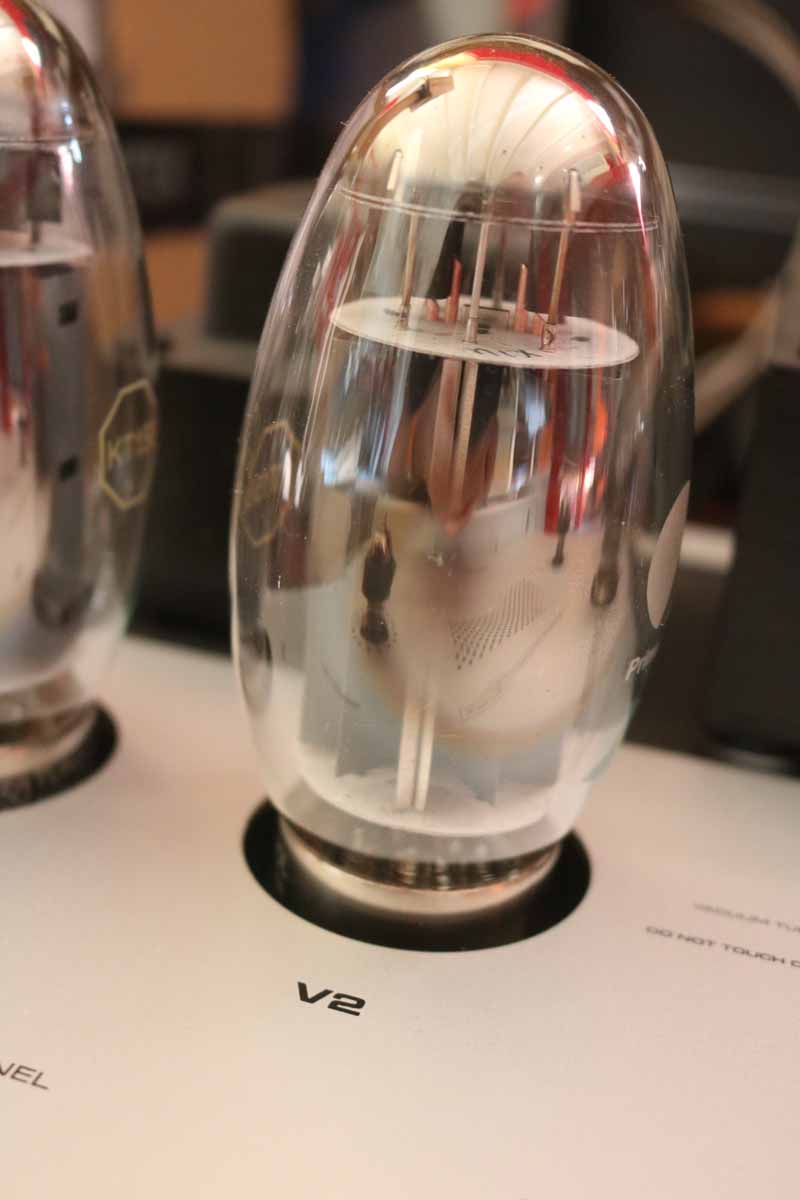
Round the back you have the usual suspects of 4 and 8 ohm taps, balanced and single-ended inputs, an hours indicator so you know how long you’ve used tubes, a defeat/auto-shut-off switch (the latter allows you to set the amp to switch off after two hours of no output), a 12V trigger in to remotely switch the amp on and off (I didn’t use this function) and the switch to change from balanced to single-ended. Other than that, you have the juice input and that’s it.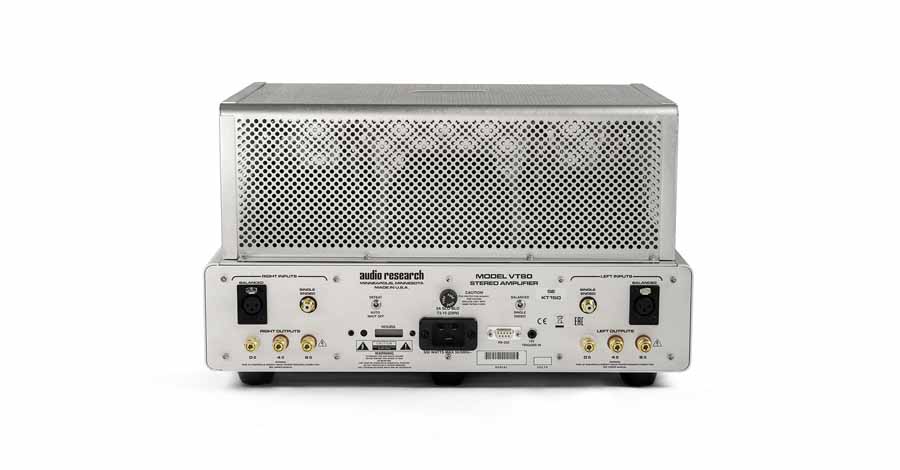
Round the front, you have the on button and when pressed the amp goes into mute mode for thirty seconds. There’s a green LED to let you know everything is getting power and that’s it. Oh, handles, it has handles which, I don’t know if I mentioned, I’m rather partial to.
You get a valve cover too to protect valves from accidental damage or prying little fingers but why would you want to hide those tubes – or so I thought until the cat showed an interest!
All in all, everything looks to be very well put together and with high-quality components being used throughout. Add a Made in USA and a three-year warranty and there is a good degree of confidence in this being a product you could rely on for years to come.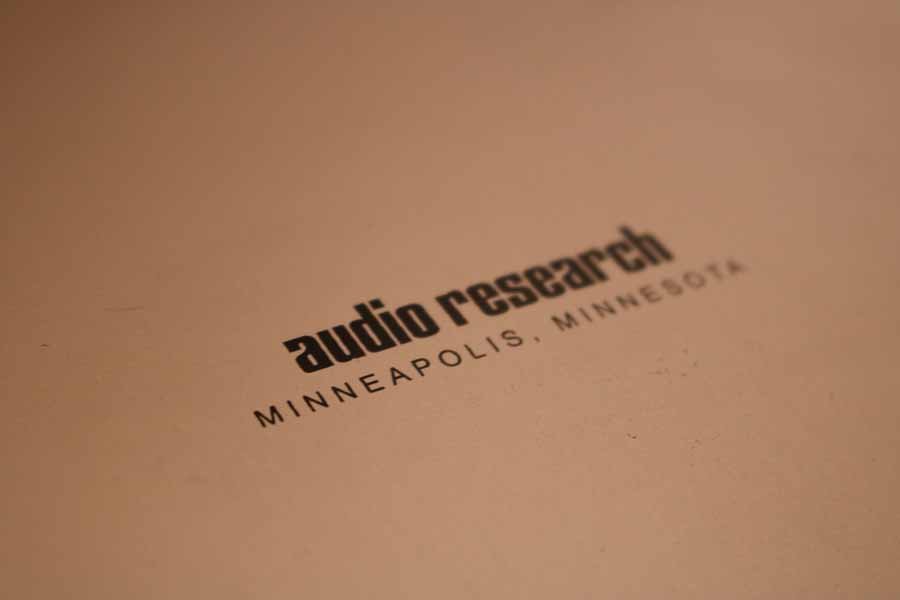
LS28 PREAMPLIFIER
The LS28 is a line-stage only preamplifier (AR make separate phonostages too for vinyl aficionados) offering four balanced and four single-ended inputs with two single-ended and two balanced outputs plus an output for taping, which is a nice touch and not always seen on preamplifiers. Inside the box, the tubes used are a trio of 6H30P, plus a couple of 6550WE and in the supply, another 6H30P is used.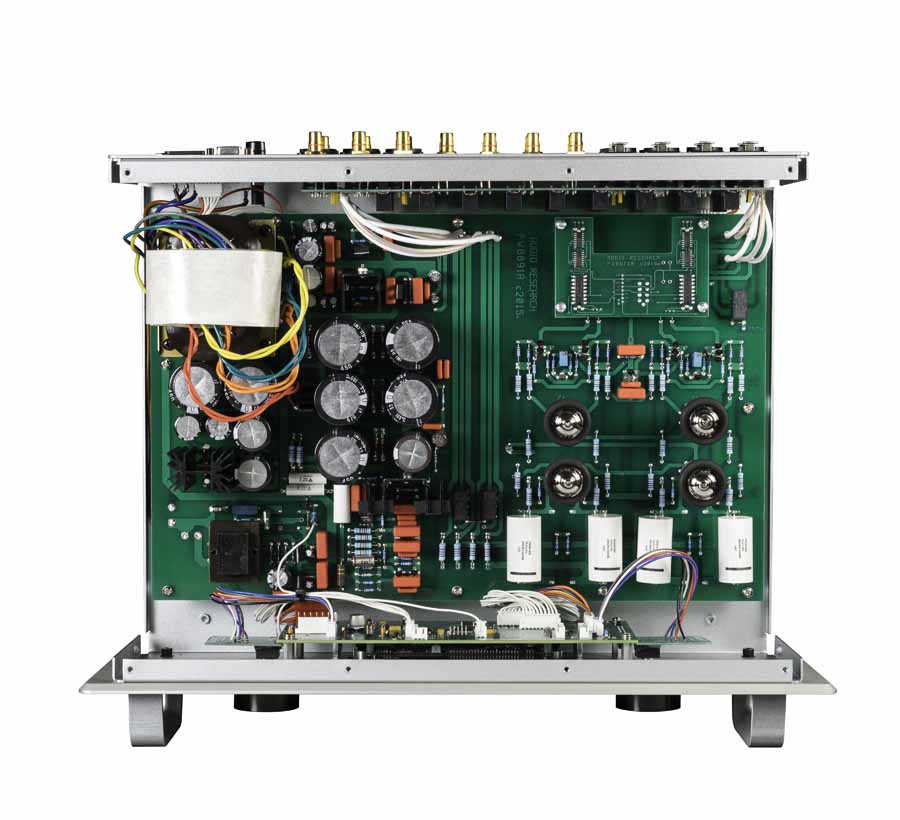
The front panel is nicely laid out and you get a 103-step rotary volume knob and the same the other side to select input. Also on the front are buttons for power, menu, enter, mono and mute, but in all honesty pretty much everything you need can be done on the very nicely made remote control that is weighty and is ideal for the armchair enthusiast. Indeed, if you are streaming your files, as I did for the duration of the review there is no need to move from your chair other than for refreshments.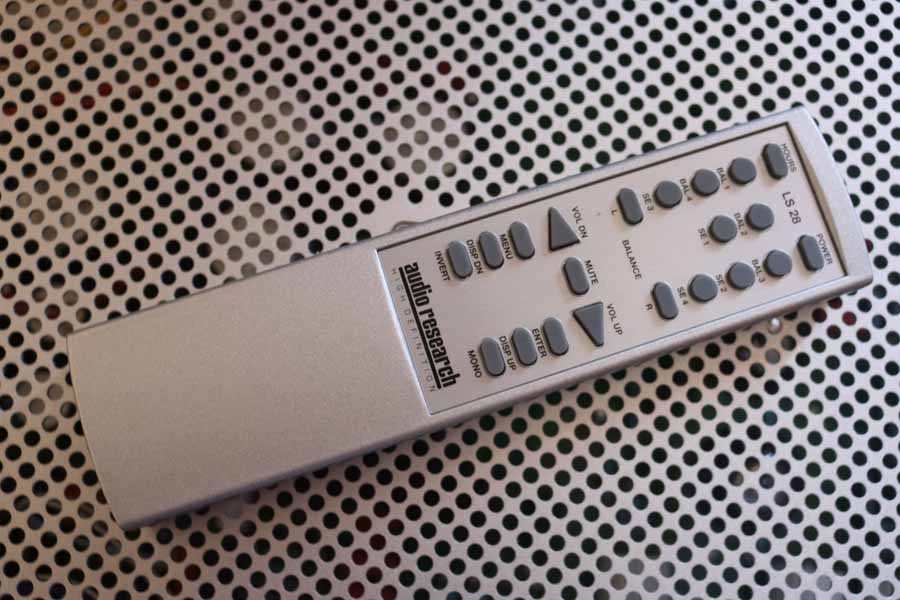
Surprisingly the preamp feels pretty lightweight when compared to the amp, but it’s equally nicely made and complements the amp perfectly in a visual sense. The front display is easy to read from a distance and is understated even at full brightness, but should you wish you can dim it by several notches or turn it off completely you can – I actually quite liked it glowing green at full brightness.
The pre has handles too – did I say I like handles on kit?
Set up of the pair is a doddle with everything being nicely spaced on the back panels allowing for plenty of space for cables. Plug everything in, let everything get up to speed, choose your input channel, turn up the volume and play your tunes.
For the review process I used the Big Six DAC from Lampizator being fed by a Melco unit. Cables were from Vermouth Audio, Chord Company, Atlas and Tellurium Q – note that the VT80SE doesn’t use a standard IEC. Speakers were Xavian Perlas which, despite their relatively modest price-point, proved an excellent march for the Audio Research power and pre.
SOUND QUALITY
Let’s face it, given what I opened this review with the expectations of this pairing, though entry-level products for Audio Research, was pretty high and from the first album I put on (10 000 Maniacs’ Our Tim In Eden) it was clear this was a class act. I wasn’t intending to listen to this record at all, it was simply one of the first records that popped up on the library, but I ended up listening to it all the way through and really enjoyed it – as I did with the 300B amp from Fezz I recently reviewed. One thing I did find useful here was the balance control which I had set one notch in favour of the right-hand speaker, allowing me to really snap the stereo image into focus from my chair. I don’t really know why balance controls fell out of favour as they offer a good degree of fine-tuning of the listening experience and allow for the vagaries of folks’ hearing and room set up. Anyway, as I said, I ended up listening to this record all the way through and was really drawn to the vocal performance that was presented with ease and clarity without a hint of harshness or feeling things were being pushed, despite me listening at relatively high volumes (20 on the pre). Detail was there in buckets and I was particularly drawn to cymbal splashes on Jezebel that just started and stopped as they should. It’s a bit of a cliché I am well aware, but the vocal was “in the room” real on How You’ve Grown but didn’t dominate – it sat slightly forward, bang central and with instrumentation sitting where it should – slightly back in the mix with lots of (reviewer cliché alert) lots of “air” around instruments. Even at loud volumes I never felt I was getting too much information or that one frequency was dominating proceedings and this is a very good thing. Balance and poise were my first impressions from this pairing but on rockier sections there was grip and power and no hint of the amp being anything but in control of the speakers.
The Waterboy’s Fisherman Blues got an airing at one point (we’d just watched the Film Fisherman’s Friend) and what really shone through was the detail and separation of instruments in the mix – that word air again. Mandolins were clearly distinct, fiddles likewise, and holding it all together the beat was presented rock solidly. I think there is a misconception out there in the world that valve amplification can be slow and sluggish, but this pairing was as nimble and sure-footed as pretty much anything I’ve heard in this system. I spend a bit of time in front of monitors in my little studio and what you look for is something that can tell you exactly what is going on in the mix and that’s what I’m getting here – of course, the speakers play a big part in this and it’s one of the reasons we chose them as our reference at this level, but the Audio Research kit seemed to add a little extra by way of uncluttering the mix and presenting it in distinct but still cohesive layers.
AC/DC’s Back in Black remained, again, rock-solid (excuse the pun) and with great feeling of the recording space, particularly at the intro. I’ve heard this record sound muddled, muddy and confused on lesser systems, but what we have here is a (very) well defined, clear and non-fatiguing sound. There’s a lot of screeching guitars and Brian Johnson’s vocal delivery is on the verge of screaming (in my opinion) but I never got overwhelmed by it all, which is a very good thing as I have been put off this record (and Gillan era Deep Purple for that matter) because I’ve been exposed to it on some systems that made it all a bit too much – play it on a great system and it’s a joy, however. Now, having said all that you may get the impression that I’m suggesting the Audio Research combo are rolling things off at the top-end – they are not – what you have is detail and clarity in the high frequencies without them ever breaking up and descending into “noise”.
By The Throat by Ben frost is a brutal assault on the self and on the system with, like the aforementioned AC/DC record, the ability to descend into a confusion of noise on poor systems. Play it on a great system and what you actually have is still a brutal assault on the self, but one that is full of different textures and tones, and that is what you have presented with the Audio Research pairing. What I’m particularly enjoying with this pre and power combination is their ability to really bring out the make-up of a record, and indeed the sounds that go together to make it. Listen closely and what may have appeared to be just a noise is actually made up of several different noises that combine to make the whole. Over analytical? Not at all! I think the thing when folk say a particular piece of equipment or system is over analytical is that the top-end has been artificially boosted. What we have here is to a great degree the reality of what is coming out the DAC. Yes, there is flavour to the sound and I would say the mid-band is pushed a little forward, but play a record like Gil Scott-Heron and Brian Jackson’s Winter in America and that actually becomes a positive in some ways – the vocal is often the thing that we as listeners hook onto and with this record that’s certainly the case for me. Having that little mid-boost allows you to hear more of the tone and more of the texture of the vocal and I think this will appeal to others also. Now, this may seem as if I’m suggesting a certain warmth to the sound – I’m not. What I am saying is that in this system and to my ears the mids are ever so slightly lifted in the mix.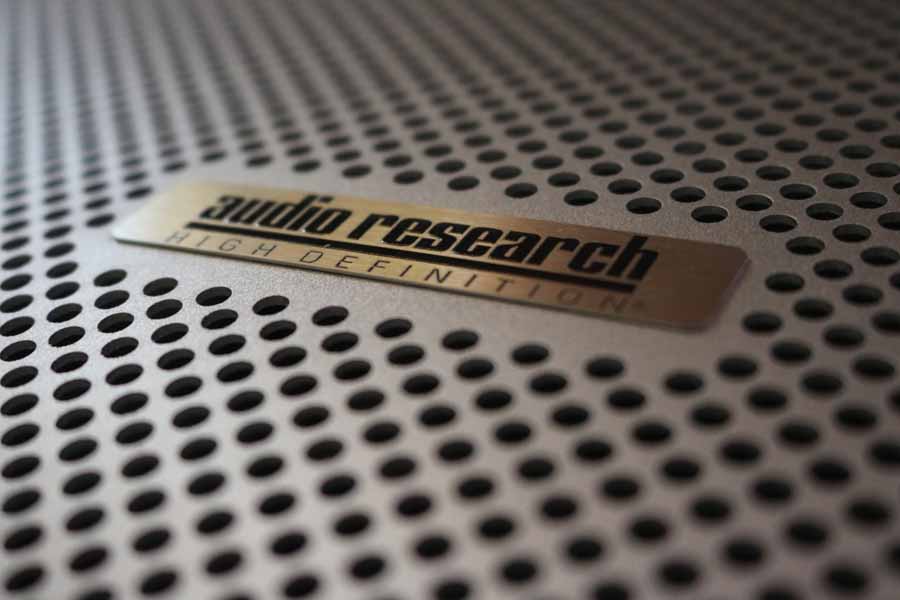
Although complete overkill on the power front I put this combo onto the Avantgarde Duo XDs which are around 107dB sensitive and have active bass. I did this for a couple of reasons: 1. To see if it would be worth investing in such a powerful amp and 2. Because I could and I thought it would be fun. It was fun and proved to be a really wonderful partnership. And had I the money I’d have contacted Ricardo at Absolute Sounds and ordered this pre and power combo without hesitation. You get that wonderful ease of sound but with the detail too and the Avantgardes just allow the Audio Research kit to sing even more. I loved it!
CONCLUSION
There sometimes comes a point in reviews and you ask yourself, can I afford or warrant another purchase of kit? And that is what happened with my time with the Audio Research pairing, despite them being their entry-level products, though i think I’d have had them in black. They are by no means cheap products, but what they bring to the table is a true audiophile listening experience that is both detailed and expressive, but they also connect you emotionally with the music you are listening to. I liked them a lot; they give the feeling that whatever you throw at them it is they that are in control of proceedings and in all my time with them and with whatever music I played through them they never once felt anything but sure-footed and poised. They have power in reserve in the system I used them in and never once did I feel like they were running out of steam or struggling with fast changes in dynamics.
Words I want to use are speed, agility, poise, air, grip and detail. I also want to say that I feel the amp is like a very well executed 300B amp but with real balls in the bass department – I want to say this because of the really beautiful and slightly pushed mids and I think this is down to that wonderful KT150 tube.
Build quality is, particularly in the power amplifier, very good, though I didn’t like the feel of the buttons on the preamplifier, but then only used them once to get a feel for them as the remote did everything I needed – I’d guess that all but the die-hard knob fiddler would be perfectly well catered for with the excellent remote control. On the other hand, the source selector knob and remote knob were both excellent to use. Some people may find the power amplifier difficult to accommodate on their rack as it is very deep, but if you are spending this kind of dosh then get something made.
What we have here can certainly be classed as high-end product and whilst not cheap, they certainly give the listener a desire to hear what products further up the Audio Research line-up can bring to the listening experience.
We don’t have an Editor’s Choice award but these would certainly be in consideration if we did.
AT A GLANCE
Build Quality: Build quality reflects the price and is excellent. My only gripe was the buttons on the preamplifier but then the excellent (and weighty) remote made them pretty much obsolete in day to day use. Those handles on the front are the icing on the cake.
Sound Quality: Controlled and speedy but with poise and detail too. A wonderfully non-fatiguing listen with detail aplenty.
Value for Money: Audio Research kit is never going to be cheap but I’ll use the old adage that you often get what you pay for. they are solid and American-made.
Pros: Build, looks, great sound and a huge pride of ownership factor. Power and poise in equal measure.
Cons: My ONLY gripe was the buttons on the pre but your mileage may vary.
Price:
LS28: £7,998
VT80SE: £8,998
Stuart Smith
Review Equipment: Lampizator Big 6 DAC, Melco Library, Xavian Perla and Avantgarde Duo XD speakers. Cables by Tellurium Q, Chord and Atlas.

























































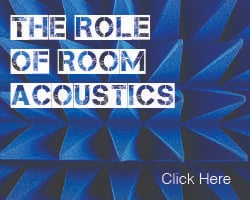











































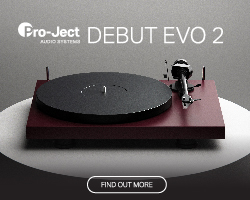











































































































You must be logged in to leave a reply.